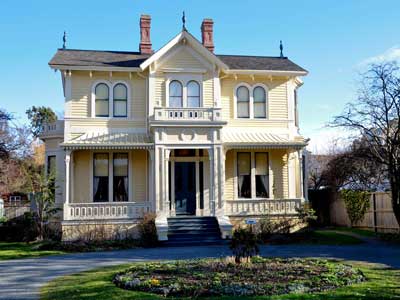Heritage Register
James Bay
207 Government Street (ex-44 Carr St)
Richard Carr House/Emily Carr House
Built
1863-64
Heritage-Designated 1980
National Historic Site
Provincial Heritage Property
For: Richard & Emily Carr
Architects: John Wright & George H. Sanders

ARCHITECTURE:
This two-storey Italianate Villa has a side-gabled roof with a central front-gabled projection creating a very formal balanced composition. The front full length verandah is broken in the centre by the entry above which, on the second floor, is a balustraded balcony. The balusters for both the verandah and balcony are pairs of fretwork “C” scrolls. The front windows are paired; the sashes of the upper windows are arched, as are those on the rear dormer. The eaves have brackets and pendants. The gables have tall slender turned urn finials. There is a pair of twin-flue corbelled and panelled brick chimneys on the main ridge of the roof, and another at the rear. The right end of the house has a two-storey angled bay, the left, a one-storey angled bay with a balcony above. The entrance has a simple Classical sidelight and transom. The rear of the house has a gabled extension and a lower hipped roof. The double-hung sashes at the rear of the house are 6-over-6. The back verandah is now enclosed. The prominent firm of Wright & Sanders designed this, their second house on Government St, after 140 Government St in 1861.
ORIGINAL OCCUPANTS:
1863-1936: The Carr family occupied this house for over 70 years. The south end of Government St below Birdcage Walk was originally known as Carr St, after Richard Carr donated land to widen the road. Richard was born in Tunbridge Wells, Kent, ENG. From 1837 he made several trips to the USA, moved to San Francisco before 1849, and became a commission agent. There he met Emily Saunders of Oxford and they travelled back to England to marry in 1855. They returned to California where daughters Edith “Dede” (1856-1919) and Clara “Tallie” (1857- 1919) were born, and by 1860 were living in Santa Clara. They moved to Victoria in 1863 in order to live under British rule but still enjoy the spacious freedom of the West Coast. They bought four acres of land adjoining Beacon Hill Park, and built this home.
Richard established a successful provisions import business on Wharf St in 1869, and acted as commission agent. He was a horticulturalist and grew award-winning produce. The other children were born in Victoria: Elizabeth “Lizzie” (1867-1936), Alice Mary (1869-1953), Emily “Millie” (1871-1945), and Richard Henry “Dick” (1875-1899). Richard died in Santa Barbara, CA, and three more sons died as infants.
Clara married Major John Nicholles of the Royal Engineers in 1882 (312 Dallas Rd ). He formed Nicholles & Renouf hardware company with Clement E. Renouf (645 Battery St, James Bay). John later deserted his family and Clara moved to Vancouver in 1915. She is the only one not buried in the family plot at Ross Bay Cemetery.
Their mother, Emily, frail throughout her life, was ill for some time, probably with TB, dying in 1886 at 50. Richard then subdivided his property and sold off nine acres. He became a recluse, spending most of his time in his garden, and died of TB in 1888 at 70.
Edith cared for her mother while she was ill, and for the children after their parents’ deaths. In 1911 the five sisters subdivided the remaining acre; each took one lot, and they sold the rest. They then built three houses in 1913 behind the family home. Edith built hers at 231 St. Andrews St. She lived there briefly with Lizzie, and they grew a garden on Lizzie’s lot to the south. They soon moved back to 207 Government and lived here until their deaths. Edith rented out rooms and bred canaries for a small income. Emily, who left the family fold to study art in San Francisco, London and Paris, built a small apartment house, Hill House, now known as the House of All Sorts, on her lot at 642-646 Simcoe St, to generate revenue. Alice became a schoolteacher and ran her first kindergarten at 620 Battery St, James Bay, then built a small home and schoolroom in the former family vegetable garden at 218-220 St. Andrews St. These houses constitute a significant historic enclave, especially because of the connection with sister Emily Carr, one of Canada’s most famous artists and writers.
OTHER OCCUPANTS:
1938-41: Adeline “Lena” (née Fleck, b. Winnipeg 1887-1977), widow of Robert Godfrey.
1942-64: William Atema (b. Netherland 1886-1970) and Sarah (née Kinders, b. Netherlands 1889-1978) operated it as a rooming house.
1964-early-70s: David Groos was instrumental in buying, saving and restoring the house. The restoration was under the direction of architect Peter Cotton. In the 1980s Stuart Stark did a restoration plan for three principle rooms, and hand-reproduced the marble wallpaper for the hallway. This house is now owned by the BC government, and managed as the Emily Carr House museum.
https://carrhouse.ca/
ADDITIONAL INFORMATION & IMAGES:
• Statement of Significance (Canadian Register of Historic Places)
• James Bay History
• James Bay Heritage Register
• This Old House, Victoria's Heritage Neighbourhoods,
Volume Two: James Bay

